Financial Analysis of AMEX and VISA Stocks using Gordon Growth Model
VerifiedAdded on 2023/05/30
|19
|4143
|171
AI Summary
This assignment conducts a financial analysis on the two banking stocks AMEX and VISA using the Gordon Growth Model. The intrinsic value of the stock was compared with the true market value of the stock and the analyst opinion on the same was given for the stock.
Contribute Materials
Your contribution can guide someone’s learning journey. Share your
documents today.

Running head: FINANCE
Finance
Name of the Student:
Name of the University:
Author’s Note:
Finance
Name of the Student:
Name of the University:
Author’s Note:
Secure Best Marks with AI Grader
Need help grading? Try our AI Grader for instant feedback on your assignments.
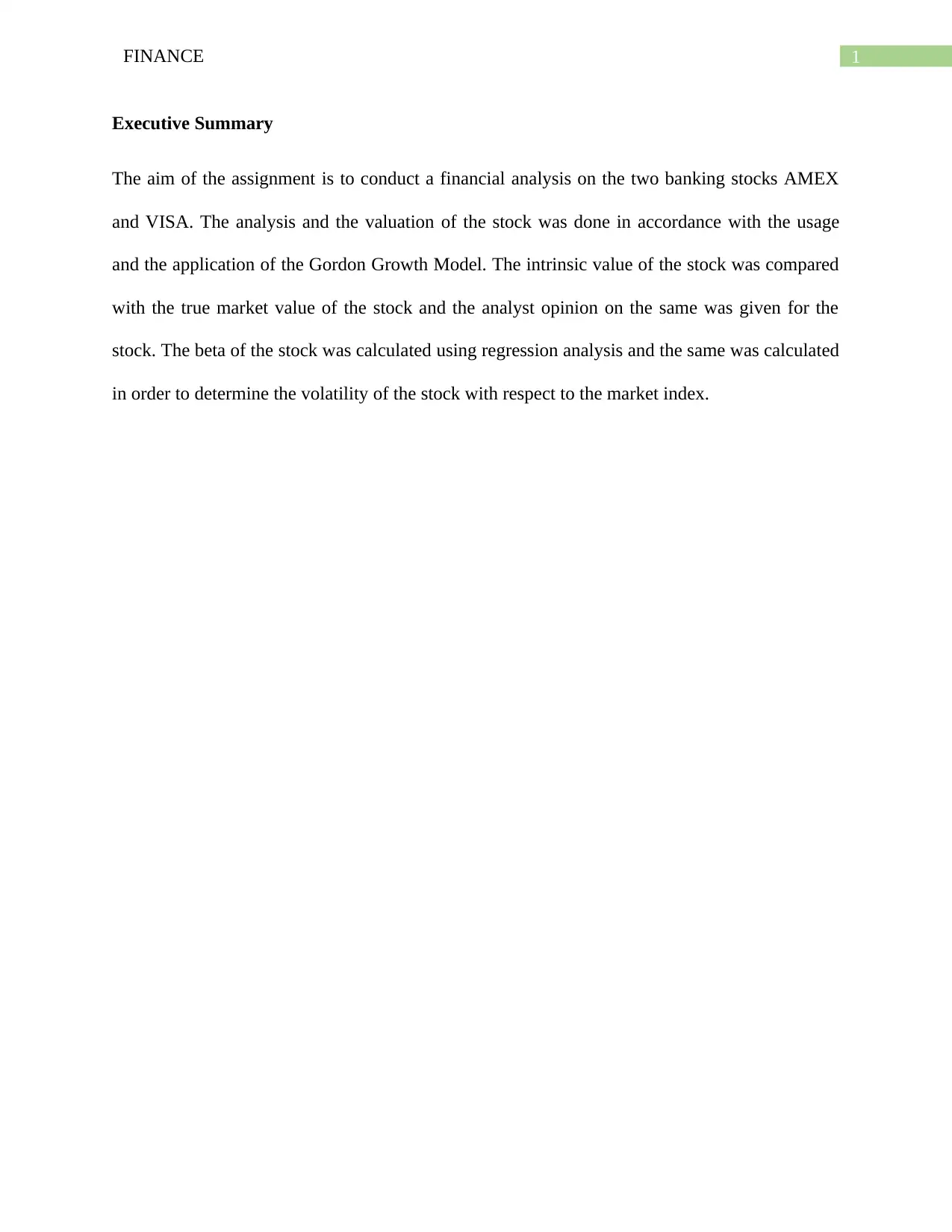
1FINANCE
Executive Summary
The aim of the assignment is to conduct a financial analysis on the two banking stocks AMEX
and VISA. The analysis and the valuation of the stock was done in accordance with the usage
and the application of the Gordon Growth Model. The intrinsic value of the stock was compared
with the true market value of the stock and the analyst opinion on the same was given for the
stock. The beta of the stock was calculated using regression analysis and the same was calculated
in order to determine the volatility of the stock with respect to the market index.
Executive Summary
The aim of the assignment is to conduct a financial analysis on the two banking stocks AMEX
and VISA. The analysis and the valuation of the stock was done in accordance with the usage
and the application of the Gordon Growth Model. The intrinsic value of the stock was compared
with the true market value of the stock and the analyst opinion on the same was given for the
stock. The beta of the stock was calculated using regression analysis and the same was calculated
in order to determine the volatility of the stock with respect to the market index.
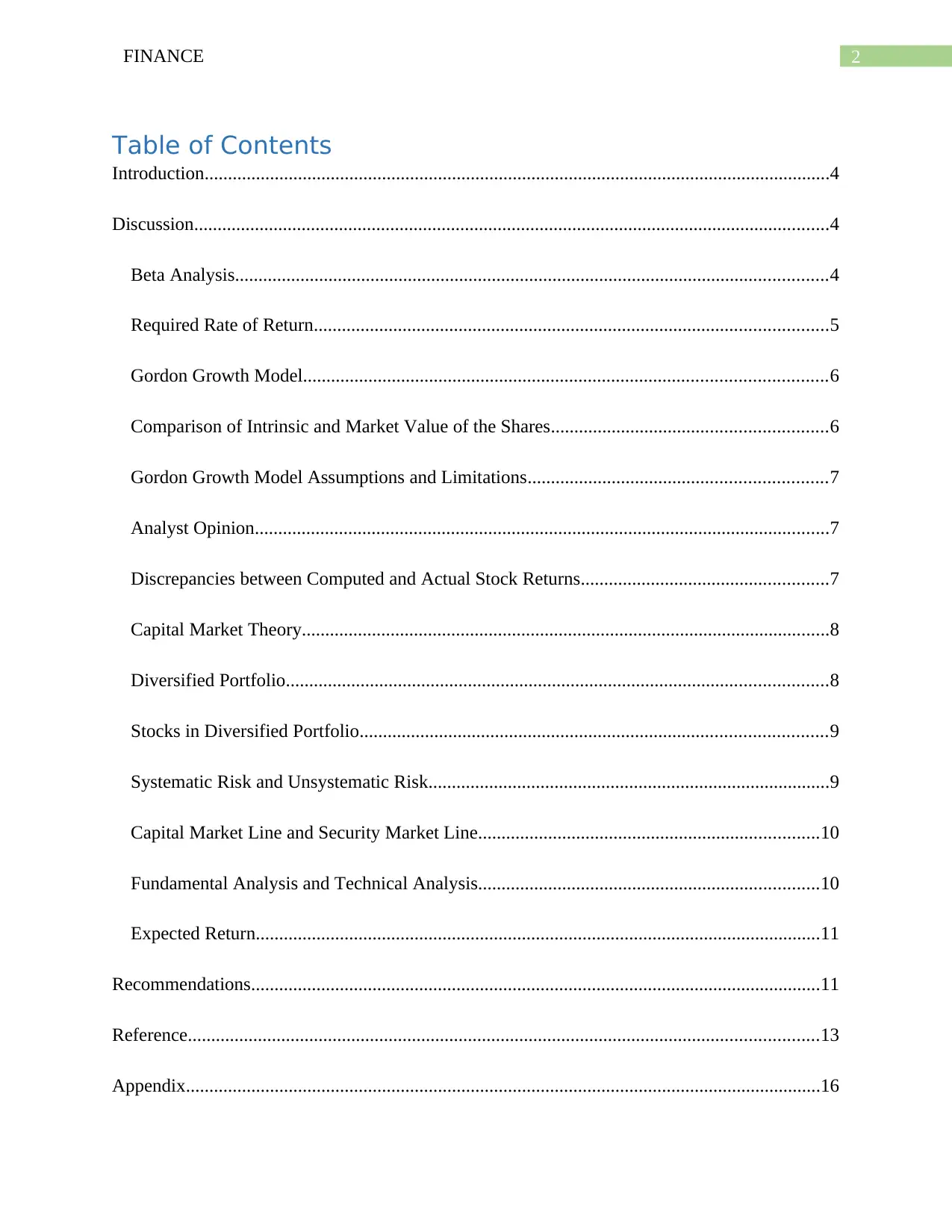
2FINANCE
Table of Contents
Introduction......................................................................................................................................4
Discussion........................................................................................................................................4
Beta Analysis...............................................................................................................................4
Required Rate of Return..............................................................................................................5
Gordon Growth Model................................................................................................................6
Comparison of Intrinsic and Market Value of the Shares...........................................................6
Gordon Growth Model Assumptions and Limitations................................................................7
Analyst Opinion...........................................................................................................................7
Discrepancies between Computed and Actual Stock Returns.....................................................7
Capital Market Theory.................................................................................................................8
Diversified Portfolio....................................................................................................................8
Stocks in Diversified Portfolio....................................................................................................9
Systematic Risk and Unsystematic Risk......................................................................................9
Capital Market Line and Security Market Line.........................................................................10
Fundamental Analysis and Technical Analysis.........................................................................10
Expected Return.........................................................................................................................11
Recommendations..........................................................................................................................11
Reference.......................................................................................................................................13
Appendix........................................................................................................................................16
Table of Contents
Introduction......................................................................................................................................4
Discussion........................................................................................................................................4
Beta Analysis...............................................................................................................................4
Required Rate of Return..............................................................................................................5
Gordon Growth Model................................................................................................................6
Comparison of Intrinsic and Market Value of the Shares...........................................................6
Gordon Growth Model Assumptions and Limitations................................................................7
Analyst Opinion...........................................................................................................................7
Discrepancies between Computed and Actual Stock Returns.....................................................7
Capital Market Theory.................................................................................................................8
Diversified Portfolio....................................................................................................................8
Stocks in Diversified Portfolio....................................................................................................9
Systematic Risk and Unsystematic Risk......................................................................................9
Capital Market Line and Security Market Line.........................................................................10
Fundamental Analysis and Technical Analysis.........................................................................10
Expected Return.........................................................................................................................11
Recommendations..........................................................................................................................11
Reference.......................................................................................................................................13
Appendix........................................................................................................................................16

3FINANCE
Appendix 2.....................................................................................................................................17
Appendix 2.....................................................................................................................................17
Secure Best Marks with AI Grader
Need help grading? Try our AI Grader for instant feedback on your assignments.
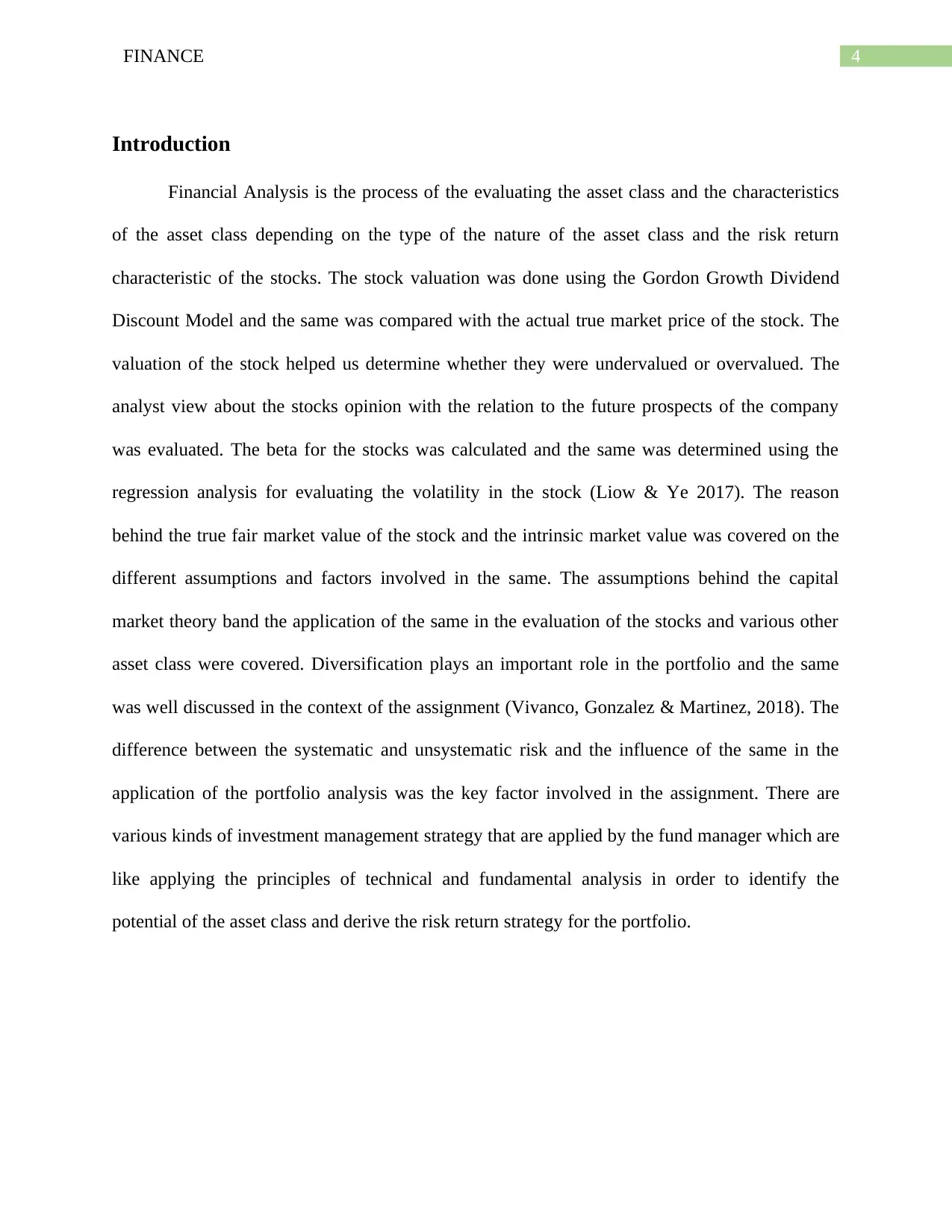
4FINANCE
Introduction
Financial Analysis is the process of the evaluating the asset class and the characteristics
of the asset class depending on the type of the nature of the asset class and the risk return
characteristic of the stocks. The stock valuation was done using the Gordon Growth Dividend
Discount Model and the same was compared with the actual true market price of the stock. The
valuation of the stock helped us determine whether they were undervalued or overvalued. The
analyst view about the stocks opinion with the relation to the future prospects of the company
was evaluated. The beta for the stocks was calculated and the same was determined using the
regression analysis for evaluating the volatility in the stock (Liow & Ye 2017). The reason
behind the true fair market value of the stock and the intrinsic market value was covered on the
different assumptions and factors involved in the same. The assumptions behind the capital
market theory band the application of the same in the evaluation of the stocks and various other
asset class were covered. Diversification plays an important role in the portfolio and the same
was well discussed in the context of the assignment (Vivanco, Gonzalez & Martinez, 2018). The
difference between the systematic and unsystematic risk and the influence of the same in the
application of the portfolio analysis was the key factor involved in the assignment. There are
various kinds of investment management strategy that are applied by the fund manager which are
like applying the principles of technical and fundamental analysis in order to identify the
potential of the asset class and derive the risk return strategy for the portfolio.
Introduction
Financial Analysis is the process of the evaluating the asset class and the characteristics
of the asset class depending on the type of the nature of the asset class and the risk return
characteristic of the stocks. The stock valuation was done using the Gordon Growth Dividend
Discount Model and the same was compared with the actual true market price of the stock. The
valuation of the stock helped us determine whether they were undervalued or overvalued. The
analyst view about the stocks opinion with the relation to the future prospects of the company
was evaluated. The beta for the stocks was calculated and the same was determined using the
regression analysis for evaluating the volatility in the stock (Liow & Ye 2017). The reason
behind the true fair market value of the stock and the intrinsic market value was covered on the
different assumptions and factors involved in the same. The assumptions behind the capital
market theory band the application of the same in the evaluation of the stocks and various other
asset class were covered. Diversification plays an important role in the portfolio and the same
was well discussed in the context of the assignment (Vivanco, Gonzalez & Martinez, 2018). The
difference between the systematic and unsystematic risk and the influence of the same in the
application of the portfolio analysis was the key factor involved in the assignment. There are
various kinds of investment management strategy that are applied by the fund manager which are
like applying the principles of technical and fundamental analysis in order to identify the
potential of the asset class and derive the risk return strategy for the portfolio.
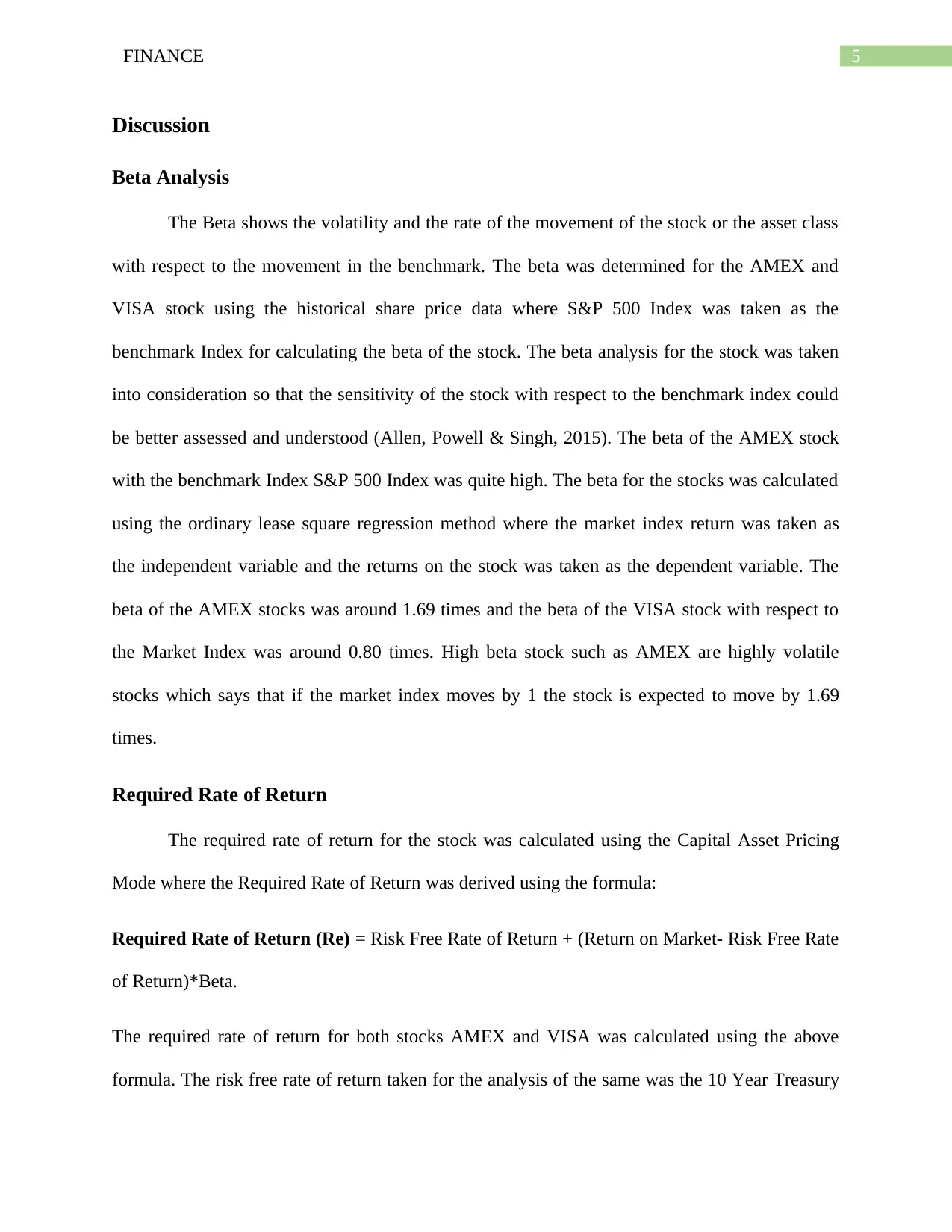
5FINANCE
Discussion
Beta Analysis
The Beta shows the volatility and the rate of the movement of the stock or the asset class
with respect to the movement in the benchmark. The beta was determined for the AMEX and
VISA stock using the historical share price data where S&P 500 Index was taken as the
benchmark Index for calculating the beta of the stock. The beta analysis for the stock was taken
into consideration so that the sensitivity of the stock with respect to the benchmark index could
be better assessed and understood (Allen, Powell & Singh, 2015). The beta of the AMEX stock
with the benchmark Index S&P 500 Index was quite high. The beta for the stocks was calculated
using the ordinary lease square regression method where the market index return was taken as
the independent variable and the returns on the stock was taken as the dependent variable. The
beta of the AMEX stocks was around 1.69 times and the beta of the VISA stock with respect to
the Market Index was around 0.80 times. High beta stock such as AMEX are highly volatile
stocks which says that if the market index moves by 1 the stock is expected to move by 1.69
times.
Required Rate of Return
The required rate of return for the stock was calculated using the Capital Asset Pricing
Mode where the Required Rate of Return was derived using the formula:
Required Rate of Return (Re) = Risk Free Rate of Return + (Return on Market- Risk Free Rate
of Return)*Beta.
The required rate of return for both stocks AMEX and VISA was calculated using the above
formula. The risk free rate of return taken for the analysis of the same was the 10 Year Treasury
Discussion
Beta Analysis
The Beta shows the volatility and the rate of the movement of the stock or the asset class
with respect to the movement in the benchmark. The beta was determined for the AMEX and
VISA stock using the historical share price data where S&P 500 Index was taken as the
benchmark Index for calculating the beta of the stock. The beta analysis for the stock was taken
into consideration so that the sensitivity of the stock with respect to the benchmark index could
be better assessed and understood (Allen, Powell & Singh, 2015). The beta of the AMEX stock
with the benchmark Index S&P 500 Index was quite high. The beta for the stocks was calculated
using the ordinary lease square regression method where the market index return was taken as
the independent variable and the returns on the stock was taken as the dependent variable. The
beta of the AMEX stocks was around 1.69 times and the beta of the VISA stock with respect to
the Market Index was around 0.80 times. High beta stock such as AMEX are highly volatile
stocks which says that if the market index moves by 1 the stock is expected to move by 1.69
times.
Required Rate of Return
The required rate of return for the stock was calculated using the Capital Asset Pricing
Mode where the Required Rate of Return was derived using the formula:
Required Rate of Return (Re) = Risk Free Rate of Return + (Return on Market- Risk Free Rate
of Return)*Beta.
The required rate of return for both stocks AMEX and VISA was calculated using the above
formula. The risk free rate of return taken for the analysis of the same was the 10 Year Treasury

6FINANCE
Yield. The return on the benchmark index S&P 500 Index was taken as the return on market and
the beta of each stock was determined in order to evaluate the required rate of return. The
required rate of return on the AMEX stock was around 10.17% and the required rate of return on
the VISA stock was around 6.48% respectively.
Gordon Growth Model
The Gordon Growth Model takes the forecasted dividend and the required rate of return
to determine the intrinsic value of the share price of the company. The Gordon Growth Dividend
Discount Model was applied in the case of VISA and AMEX shares were the intrinsic value for
the shares were determined in order to calculate and evaluate the pricing of the stock. The
formula used for determining the intrinsic value of the shares was:
Intrinsic Value (I.V) = (D1/(1+Re)+(D2/(1+Re)+(D3/(1+Re))+(D4/(1+Re))+(P4/(Re-g)).
The Gordon growth model was taken into consideration for determining the intrinsic
value of the share and the above formula was used for determining the current intrinsic value of
the share and the required rate of return was also use in the evaluation of the same. The intrinsic
value of the AMEX share was derived as $27.84 and the value of the VISA share was
determined as $242.85.
Comparison of Intrinsic and Market Value of the Shares
The intrinsic value of the shares was determined using the GGM model and the intrinsic
price of the AMEX share was determined to be around $27.84 however the current market value
of the share was around $112.89. The current market value of the share was currently high,
which shows the overvaluation of the share in the current given market situation. The intrinsic
value of the share for VISA share was evaluated to be around $242.85 and the market value of
Yield. The return on the benchmark index S&P 500 Index was taken as the return on market and
the beta of each stock was determined in order to evaluate the required rate of return. The
required rate of return on the AMEX stock was around 10.17% and the required rate of return on
the VISA stock was around 6.48% respectively.
Gordon Growth Model
The Gordon Growth Model takes the forecasted dividend and the required rate of return
to determine the intrinsic value of the share price of the company. The Gordon Growth Dividend
Discount Model was applied in the case of VISA and AMEX shares were the intrinsic value for
the shares were determined in order to calculate and evaluate the pricing of the stock. The
formula used for determining the intrinsic value of the shares was:
Intrinsic Value (I.V) = (D1/(1+Re)+(D2/(1+Re)+(D3/(1+Re))+(D4/(1+Re))+(P4/(Re-g)).
The Gordon growth model was taken into consideration for determining the intrinsic
value of the share and the above formula was used for determining the current intrinsic value of
the share and the required rate of return was also use in the evaluation of the same. The intrinsic
value of the AMEX share was derived as $27.84 and the value of the VISA share was
determined as $242.85.
Comparison of Intrinsic and Market Value of the Shares
The intrinsic value of the shares was determined using the GGM model and the intrinsic
price of the AMEX share was determined to be around $27.84 however the current market value
of the share was around $112.89. The current market value of the share was currently high,
which shows the overvaluation of the share in the current given market situation. The intrinsic
value of the share for VISA share was evaluated to be around $242.85 and the market value of
Paraphrase This Document
Need a fresh take? Get an instant paraphrase of this document with our AI Paraphraser
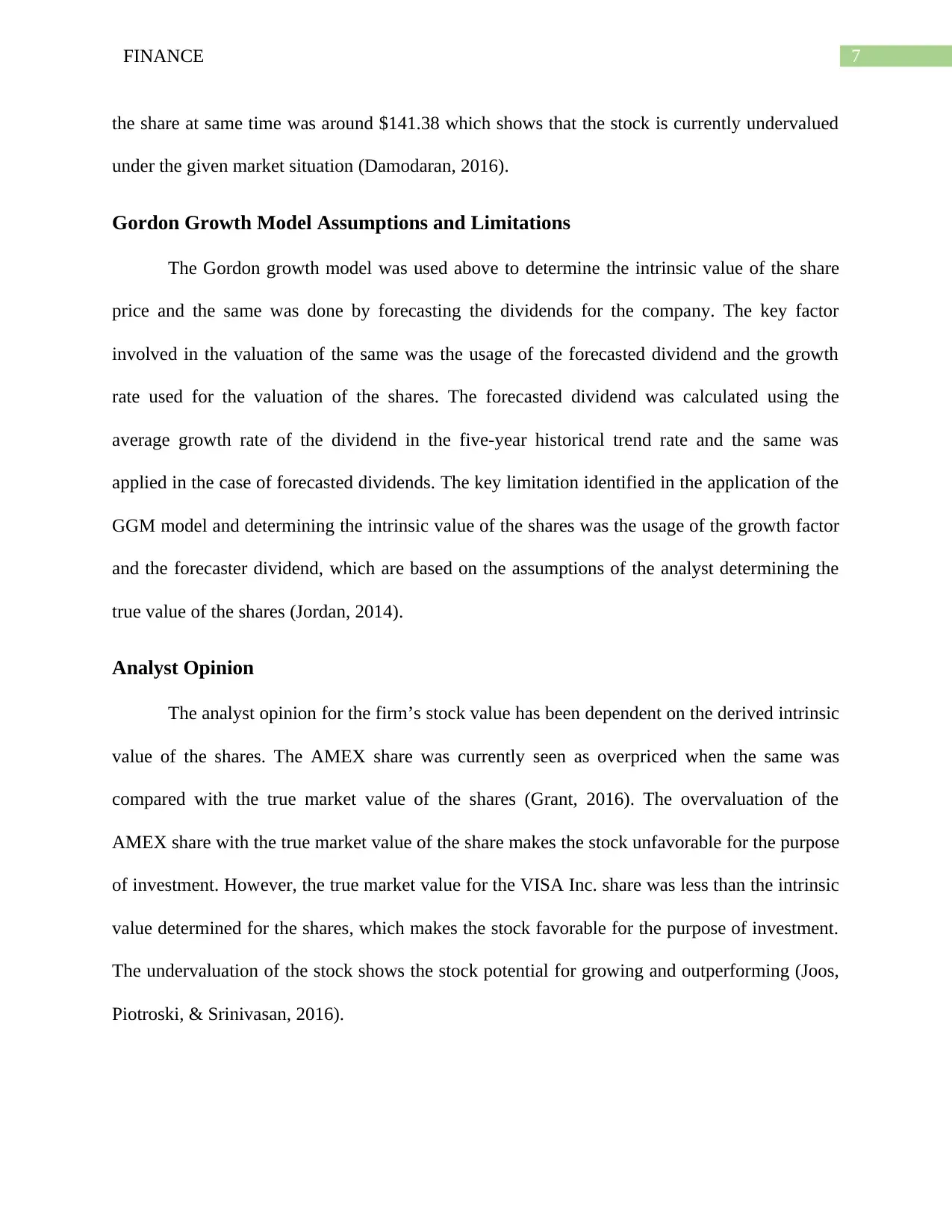
7FINANCE
the share at same time was around $141.38 which shows that the stock is currently undervalued
under the given market situation (Damodaran, 2016).
Gordon Growth Model Assumptions and Limitations
The Gordon growth model was used above to determine the intrinsic value of the share
price and the same was done by forecasting the dividends for the company. The key factor
involved in the valuation of the same was the usage of the forecasted dividend and the growth
rate used for the valuation of the shares. The forecasted dividend was calculated using the
average growth rate of the dividend in the five-year historical trend rate and the same was
applied in the case of forecasted dividends. The key limitation identified in the application of the
GGM model and determining the intrinsic value of the shares was the usage of the growth factor
and the forecaster dividend, which are based on the assumptions of the analyst determining the
true value of the shares (Jordan, 2014).
Analyst Opinion
The analyst opinion for the firm’s stock value has been dependent on the derived intrinsic
value of the shares. The AMEX share was currently seen as overpriced when the same was
compared with the true market value of the shares (Grant, 2016). The overvaluation of the
AMEX share with the true market value of the share makes the stock unfavorable for the purpose
of investment. However, the true market value for the VISA Inc. share was less than the intrinsic
value determined for the shares, which makes the stock favorable for the purpose of investment.
The undervaluation of the stock shows the stock potential for growing and outperforming (Joos,
Piotroski, & Srinivasan, 2016).
the share at same time was around $141.38 which shows that the stock is currently undervalued
under the given market situation (Damodaran, 2016).
Gordon Growth Model Assumptions and Limitations
The Gordon growth model was used above to determine the intrinsic value of the share
price and the same was done by forecasting the dividends for the company. The key factor
involved in the valuation of the same was the usage of the forecasted dividend and the growth
rate used for the valuation of the shares. The forecasted dividend was calculated using the
average growth rate of the dividend in the five-year historical trend rate and the same was
applied in the case of forecasted dividends. The key limitation identified in the application of the
GGM model and determining the intrinsic value of the shares was the usage of the growth factor
and the forecaster dividend, which are based on the assumptions of the analyst determining the
true value of the shares (Jordan, 2014).
Analyst Opinion
The analyst opinion for the firm’s stock value has been dependent on the derived intrinsic
value of the shares. The AMEX share was currently seen as overpriced when the same was
compared with the true market value of the shares (Grant, 2016). The overvaluation of the
AMEX share with the true market value of the share makes the stock unfavorable for the purpose
of investment. However, the true market value for the VISA Inc. share was less than the intrinsic
value determined for the shares, which makes the stock favorable for the purpose of investment.
The undervaluation of the stock shows the stock potential for growing and outperforming (Joos,
Piotroski, & Srinivasan, 2016).
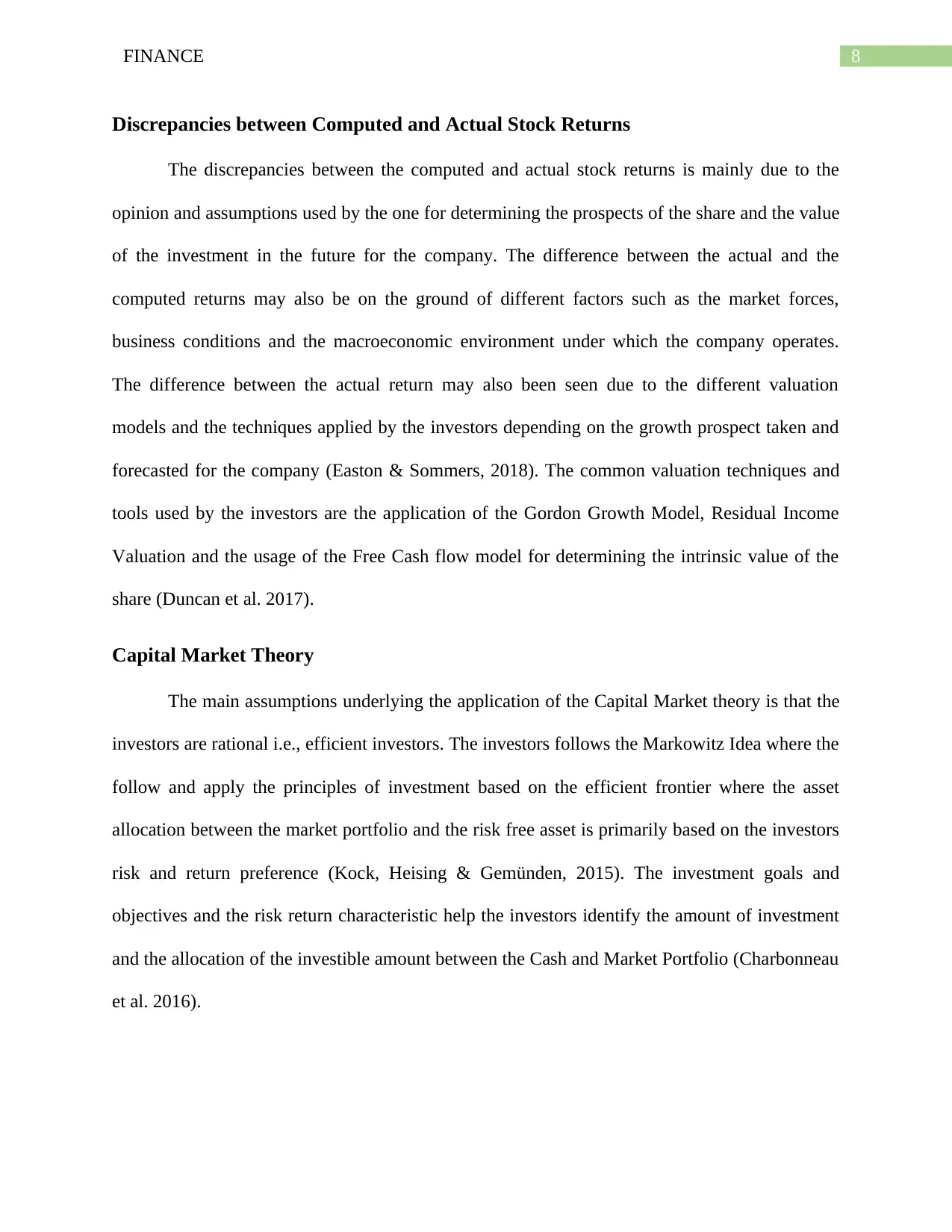
8FINANCE
Discrepancies between Computed and Actual Stock Returns
The discrepancies between the computed and actual stock returns is mainly due to the
opinion and assumptions used by the one for determining the prospects of the share and the value
of the investment in the future for the company. The difference between the actual and the
computed returns may also be on the ground of different factors such as the market forces,
business conditions and the macroeconomic environment under which the company operates.
The difference between the actual return may also been seen due to the different valuation
models and the techniques applied by the investors depending on the growth prospect taken and
forecasted for the company (Easton & Sommers, 2018). The common valuation techniques and
tools used by the investors are the application of the Gordon Growth Model, Residual Income
Valuation and the usage of the Free Cash flow model for determining the intrinsic value of the
share (Duncan et al. 2017).
Capital Market Theory
The main assumptions underlying the application of the Capital Market theory is that the
investors are rational i.e., efficient investors. The investors follows the Markowitz Idea where the
follow and apply the principles of investment based on the efficient frontier where the asset
allocation between the market portfolio and the risk free asset is primarily based on the investors
risk and return preference (Kock, Heising & Gemünden, 2015). The investment goals and
objectives and the risk return characteristic help the investors identify the amount of investment
and the allocation of the investible amount between the Cash and Market Portfolio (Charbonneau
et al. 2016).
Discrepancies between Computed and Actual Stock Returns
The discrepancies between the computed and actual stock returns is mainly due to the
opinion and assumptions used by the one for determining the prospects of the share and the value
of the investment in the future for the company. The difference between the actual and the
computed returns may also be on the ground of different factors such as the market forces,
business conditions and the macroeconomic environment under which the company operates.
The difference between the actual return may also been seen due to the different valuation
models and the techniques applied by the investors depending on the growth prospect taken and
forecasted for the company (Easton & Sommers, 2018). The common valuation techniques and
tools used by the investors are the application of the Gordon Growth Model, Residual Income
Valuation and the usage of the Free Cash flow model for determining the intrinsic value of the
share (Duncan et al. 2017).
Capital Market Theory
The main assumptions underlying the application of the Capital Market theory is that the
investors are rational i.e., efficient investors. The investors follows the Markowitz Idea where the
follow and apply the principles of investment based on the efficient frontier where the asset
allocation between the market portfolio and the risk free asset is primarily based on the investors
risk and return preference (Kock, Heising & Gemünden, 2015). The investment goals and
objectives and the risk return characteristic help the investors identify the amount of investment
and the allocation of the investible amount between the Cash and Market Portfolio (Charbonneau
et al. 2016).

9FINANCE
Diversified Portfolio
A diversified portfolio is one where the unsystematic risk in the portfolio is reduced by
investing the portfolio amount into various kind and categories of assets so that the unsystematic
risk of the portfolio is reduced. A diversified portfolio is one where the investible amount is
diversified into various asset class so that risk and return derived from the same is modified. The
risk and return from the portfolio are modified, as the weights of the stocks will be put according
to the risk return profile of the asset class (Bollen, Joenväärä & Kauppila, 2018).
Stocks in Diversified Portfolio
Portfolio with diversified stocks usually modifies the risk and return strategy and the
same will create a better-diversified portfolio reducing the risk and return characteristics of the
stocks. The portfolio will be created on the base of the different stocks, which will provide a risk
diversification and return generation for the stocks (Auerbach, 2015). As such, there are no
limitation on the number of stocks required for creation of a diversified portfolio but the number
of stocks to be included in the portfolio should be based on the cost benefit analysis in the
portfolio. However, the number of stocks required for a portfolio should at least be 5-6 stocks,
which should be uncorrelated and should be from different industries and sectors (Campbell et
al. 2018).
Systematic Risk and Unsystematic Risk
There are primary two common risk faced by the investors during the investment process,
which are primarily systematic risk and unsystematic risk (McIntosh, Fitzgerald & Kirk 2017).
Systematic risk is the type of risk, where the risk and return of the stock is dependent on the
performance of the economy or the market risk, which is faced by the investors at the time of
investing the same with the stocks. Systematic risk may be referred to the daily volatility faced
Diversified Portfolio
A diversified portfolio is one where the unsystematic risk in the portfolio is reduced by
investing the portfolio amount into various kind and categories of assets so that the unsystematic
risk of the portfolio is reduced. A diversified portfolio is one where the investible amount is
diversified into various asset class so that risk and return derived from the same is modified. The
risk and return from the portfolio are modified, as the weights of the stocks will be put according
to the risk return profile of the asset class (Bollen, Joenväärä & Kauppila, 2018).
Stocks in Diversified Portfolio
Portfolio with diversified stocks usually modifies the risk and return strategy and the
same will create a better-diversified portfolio reducing the risk and return characteristics of the
stocks. The portfolio will be created on the base of the different stocks, which will provide a risk
diversification and return generation for the stocks (Auerbach, 2015). As such, there are no
limitation on the number of stocks required for creation of a diversified portfolio but the number
of stocks to be included in the portfolio should be based on the cost benefit analysis in the
portfolio. However, the number of stocks required for a portfolio should at least be 5-6 stocks,
which should be uncorrelated and should be from different industries and sectors (Campbell et
al. 2018).
Systematic Risk and Unsystematic Risk
There are primary two common risk faced by the investors during the investment process,
which are primarily systematic risk and unsystematic risk (McIntosh, Fitzgerald & Kirk 2017).
Systematic risk is the type of risk, where the risk and return of the stock is dependent on the
performance of the economy or the market risk, which is faced by the investors at the time of
investing the same with the stocks. Systematic risk may be referred to the daily volatility faced
Secure Best Marks with AI Grader
Need help grading? Try our AI Grader for instant feedback on your assignments.
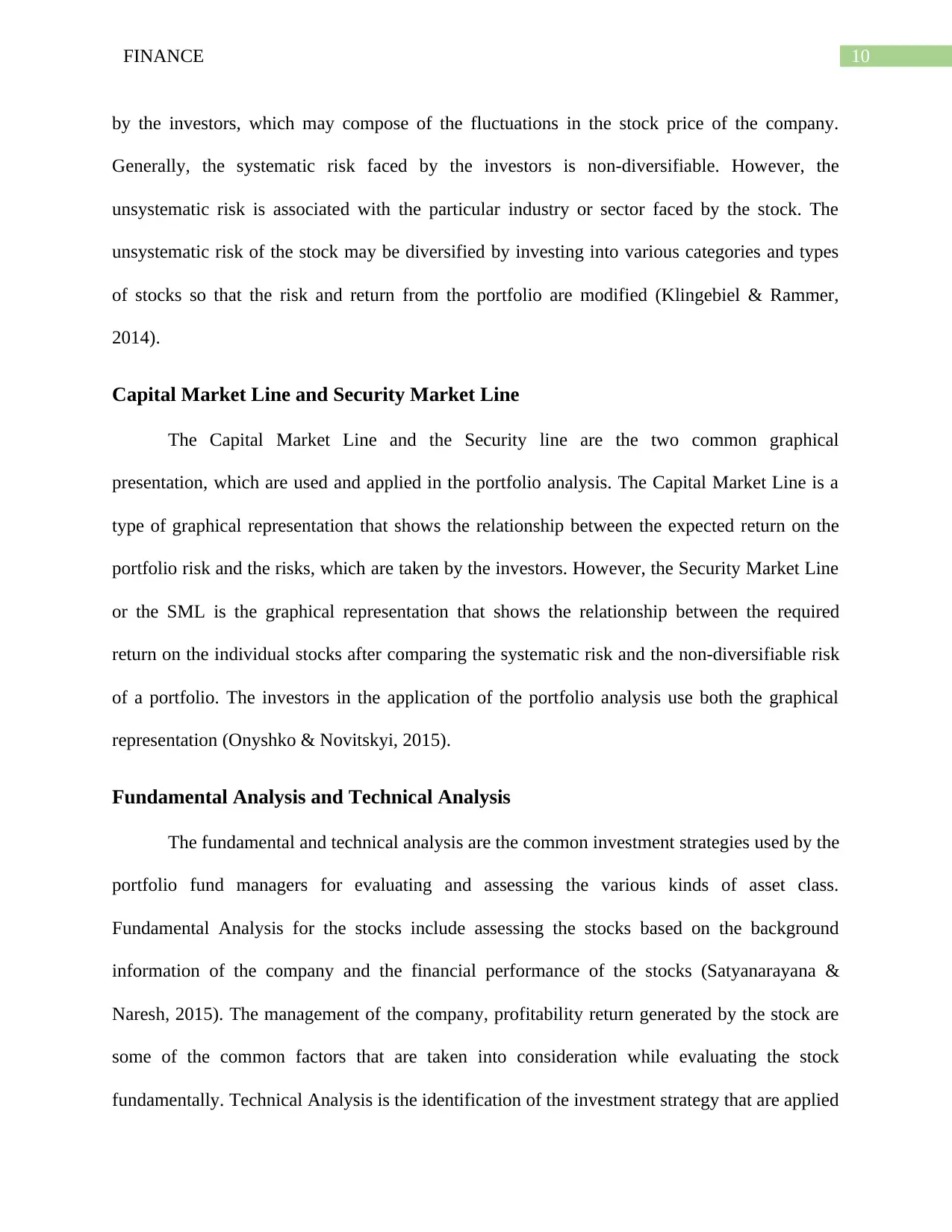
10FINANCE
by the investors, which may compose of the fluctuations in the stock price of the company.
Generally, the systematic risk faced by the investors is non-diversifiable. However, the
unsystematic risk is associated with the particular industry or sector faced by the stock. The
unsystematic risk of the stock may be diversified by investing into various categories and types
of stocks so that the risk and return from the portfolio are modified (Klingebiel & Rammer,
2014).
Capital Market Line and Security Market Line
The Capital Market Line and the Security line are the two common graphical
presentation, which are used and applied in the portfolio analysis. The Capital Market Line is a
type of graphical representation that shows the relationship between the expected return on the
portfolio risk and the risks, which are taken by the investors. However, the Security Market Line
or the SML is the graphical representation that shows the relationship between the required
return on the individual stocks after comparing the systematic risk and the non-diversifiable risk
of a portfolio. The investors in the application of the portfolio analysis use both the graphical
representation (Onyshko & Novitskyi, 2015).
Fundamental Analysis and Technical Analysis
The fundamental and technical analysis are the common investment strategies used by the
portfolio fund managers for evaluating and assessing the various kinds of asset class.
Fundamental Analysis for the stocks include assessing the stocks based on the background
information of the company and the financial performance of the stocks (Satyanarayana &
Naresh, 2015). The management of the company, profitability return generated by the stock are
some of the common factors that are taken into consideration while evaluating the stock
fundamentally. Technical Analysis is the identification of the investment strategy that are applied
by the investors, which may compose of the fluctuations in the stock price of the company.
Generally, the systematic risk faced by the investors is non-diversifiable. However, the
unsystematic risk is associated with the particular industry or sector faced by the stock. The
unsystematic risk of the stock may be diversified by investing into various categories and types
of stocks so that the risk and return from the portfolio are modified (Klingebiel & Rammer,
2014).
Capital Market Line and Security Market Line
The Capital Market Line and the Security line are the two common graphical
presentation, which are used and applied in the portfolio analysis. The Capital Market Line is a
type of graphical representation that shows the relationship between the expected return on the
portfolio risk and the risks, which are taken by the investors. However, the Security Market Line
or the SML is the graphical representation that shows the relationship between the required
return on the individual stocks after comparing the systematic risk and the non-diversifiable risk
of a portfolio. The investors in the application of the portfolio analysis use both the graphical
representation (Onyshko & Novitskyi, 2015).
Fundamental Analysis and Technical Analysis
The fundamental and technical analysis are the common investment strategies used by the
portfolio fund managers for evaluating and assessing the various kinds of asset class.
Fundamental Analysis for the stocks include assessing the stocks based on the background
information of the company and the financial performance of the stocks (Satyanarayana &
Naresh, 2015). The management of the company, profitability return generated by the stock are
some of the common factors that are taken into consideration while evaluating the stock
fundamentally. Technical Analysis is the identification of the investment strategy that are applied

11FINANCE
by the investors for identifying the trade opportunities by analyzing the statistical trends, charts,
volume of the shares and other tools to determine and forecast the share price of the company.
Forecasting of market prices and the study of the market prices of the data given for the company
are some of the factors taken into consideration while conducting the technical analysis for the
stock.
Expected Return
There are two common ways where the required rate of return for the stocks could be determined
are by using:
Capital Asset Pricing Model (CAPM): The Capital Asset Pricing model is the
commo0n techniques used for determining the expected required rate of return. The
formula used for determining the same is as follows:
Required Rate of Return (Re) = Risk Free Rate of Return + (Return on Market- Risk
Free Rate of Return)*Beta (Barberis et al. 2015).
Weighted Average Cost of Capital (WACC): The weighted average cost of capital for
the firm is the other technique applied for the usage of determining the required rate of
return from the stock (Chandra, 2017). The formula used for the same is as follow:
WACC: Weight of Equity*Cost of Equity+ Weight of Debt* Cost of Debt.
Recommendations
The current valuation for the AMEX and VISA shares were determined using the Gordon
Growth Model and the same was determined in order to determine the undervaluation or the
overvaluation of the share price of the company. The intrinsic price of the AMEX share was
determined to be around $27.84 however the current market value of the share was around
by the investors for identifying the trade opportunities by analyzing the statistical trends, charts,
volume of the shares and other tools to determine and forecast the share price of the company.
Forecasting of market prices and the study of the market prices of the data given for the company
are some of the factors taken into consideration while conducting the technical analysis for the
stock.
Expected Return
There are two common ways where the required rate of return for the stocks could be determined
are by using:
Capital Asset Pricing Model (CAPM): The Capital Asset Pricing model is the
commo0n techniques used for determining the expected required rate of return. The
formula used for determining the same is as follows:
Required Rate of Return (Re) = Risk Free Rate of Return + (Return on Market- Risk
Free Rate of Return)*Beta (Barberis et al. 2015).
Weighted Average Cost of Capital (WACC): The weighted average cost of capital for
the firm is the other technique applied for the usage of determining the required rate of
return from the stock (Chandra, 2017). The formula used for the same is as follow:
WACC: Weight of Equity*Cost of Equity+ Weight of Debt* Cost of Debt.
Recommendations
The current valuation for the AMEX and VISA shares were determined using the Gordon
Growth Model and the same was determined in order to determine the undervaluation or the
overvaluation of the share price of the company. The intrinsic price of the AMEX share was
determined to be around $27.84 however the current market value of the share was around
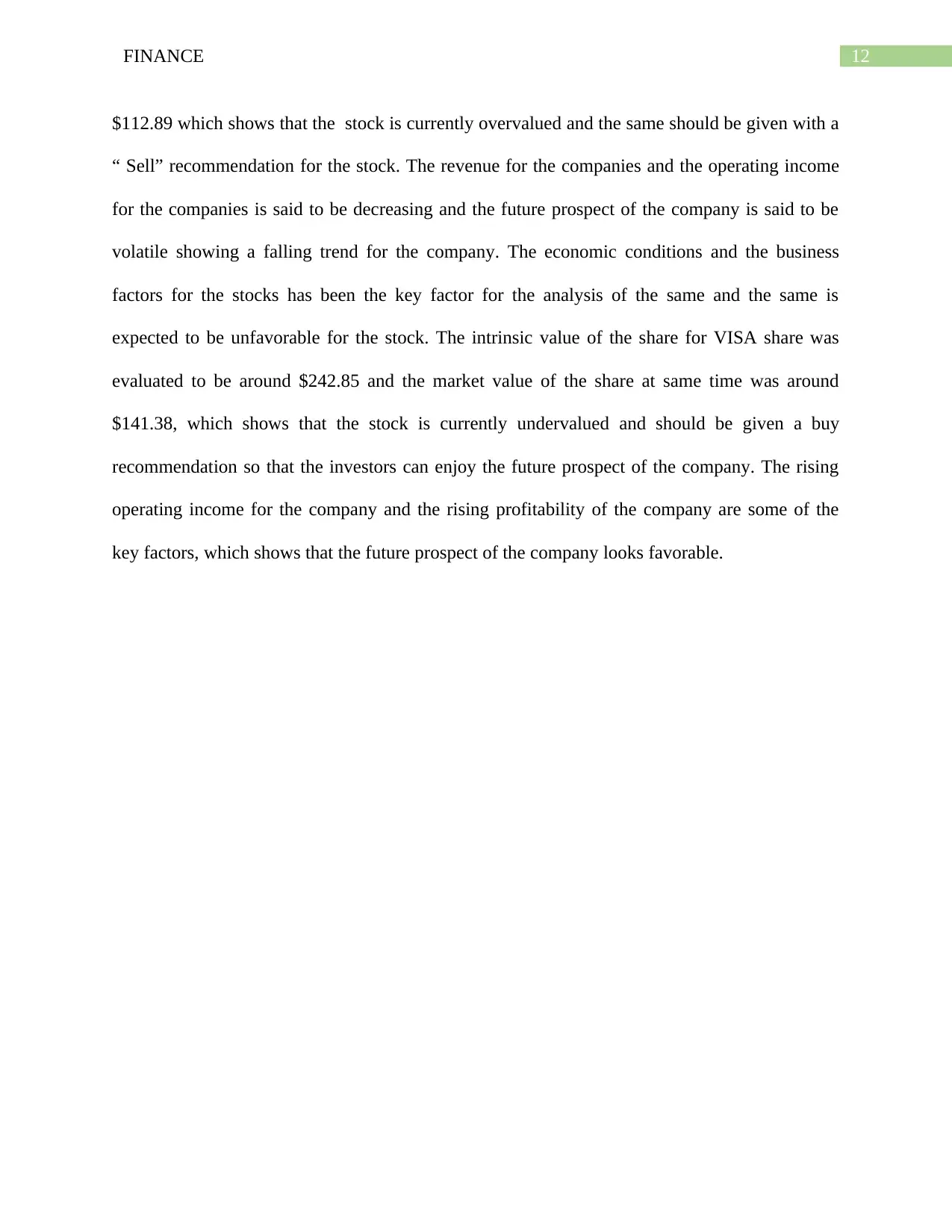
12FINANCE
$112.89 which shows that the stock is currently overvalued and the same should be given with a
“ Sell” recommendation for the stock. The revenue for the companies and the operating income
for the companies is said to be decreasing and the future prospect of the company is said to be
volatile showing a falling trend for the company. The economic conditions and the business
factors for the stocks has been the key factor for the analysis of the same and the same is
expected to be unfavorable for the stock. The intrinsic value of the share for VISA share was
evaluated to be around $242.85 and the market value of the share at same time was around
$141.38, which shows that the stock is currently undervalued and should be given a buy
recommendation so that the investors can enjoy the future prospect of the company. The rising
operating income for the company and the rising profitability of the company are some of the
key factors, which shows that the future prospect of the company looks favorable.
$112.89 which shows that the stock is currently overvalued and the same should be given with a
“ Sell” recommendation for the stock. The revenue for the companies and the operating income
for the companies is said to be decreasing and the future prospect of the company is said to be
volatile showing a falling trend for the company. The economic conditions and the business
factors for the stocks has been the key factor for the analysis of the same and the same is
expected to be unfavorable for the stock. The intrinsic value of the share for VISA share was
evaluated to be around $242.85 and the market value of the share at same time was around
$141.38, which shows that the stock is currently undervalued and should be given a buy
recommendation so that the investors can enjoy the future prospect of the company. The rising
operating income for the company and the rising profitability of the company are some of the
key factors, which shows that the future prospect of the company looks favorable.
Paraphrase This Document
Need a fresh take? Get an instant paraphrase of this document with our AI Paraphraser
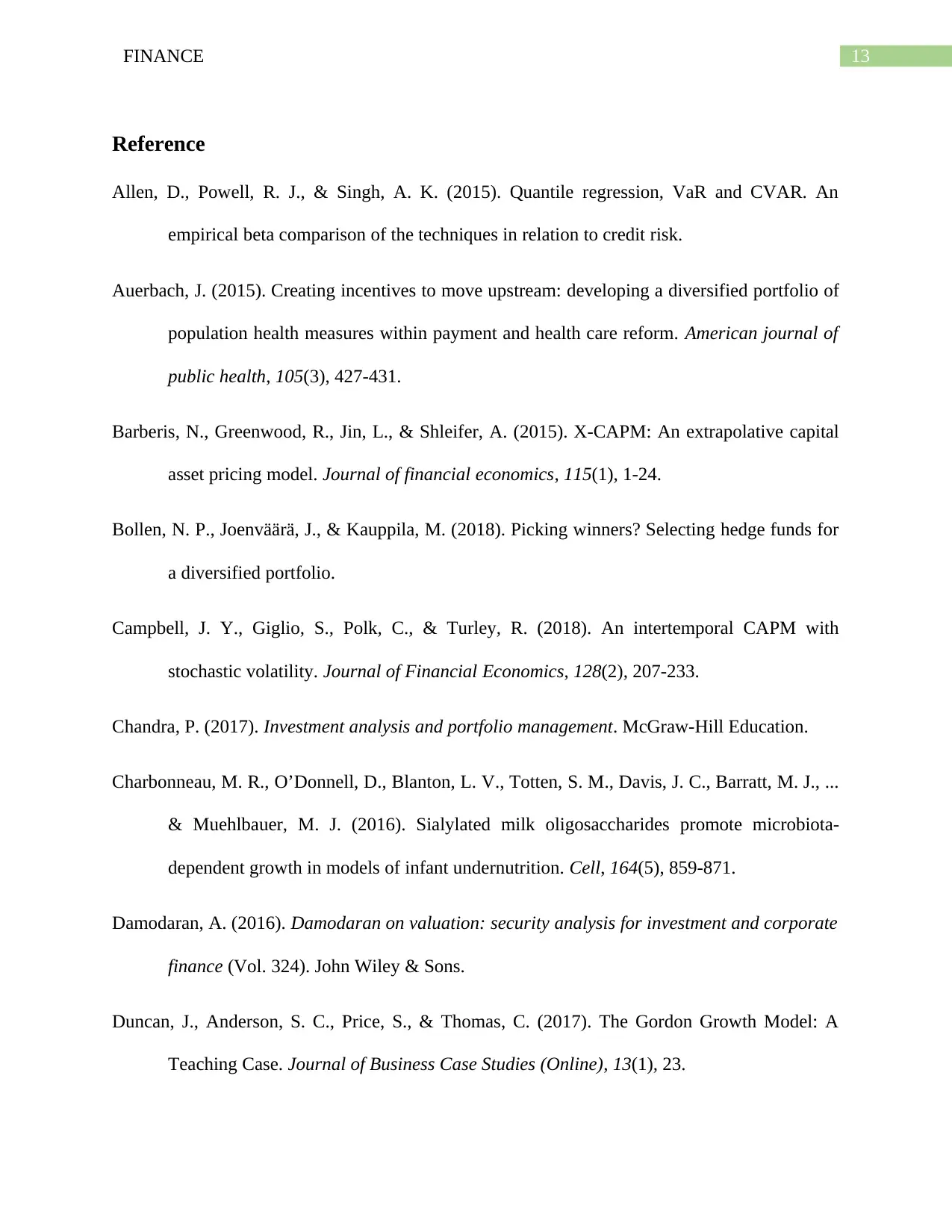
13FINANCE
Reference
Allen, D., Powell, R. J., & Singh, A. K. (2015). Quantile regression, VaR and CVAR. An
empirical beta comparison of the techniques in relation to credit risk.
Auerbach, J. (2015). Creating incentives to move upstream: developing a diversified portfolio of
population health measures within payment and health care reform. American journal of
public health, 105(3), 427-431.
Barberis, N., Greenwood, R., Jin, L., & Shleifer, A. (2015). X-CAPM: An extrapolative capital
asset pricing model. Journal of financial economics, 115(1), 1-24.
Bollen, N. P., Joenväärä, J., & Kauppila, M. (2018). Picking winners? Selecting hedge funds for
a diversified portfolio.
Campbell, J. Y., Giglio, S., Polk, C., & Turley, R. (2018). An intertemporal CAPM with
stochastic volatility. Journal of Financial Economics, 128(2), 207-233.
Chandra, P. (2017). Investment analysis and portfolio management. McGraw-Hill Education.
Charbonneau, M. R., O’Donnell, D., Blanton, L. V., Totten, S. M., Davis, J. C., Barratt, M. J., ...
& Muehlbauer, M. J. (2016). Sialylated milk oligosaccharides promote microbiota-
dependent growth in models of infant undernutrition. Cell, 164(5), 859-871.
Damodaran, A. (2016). Damodaran on valuation: security analysis for investment and corporate
finance (Vol. 324). John Wiley & Sons.
Duncan, J., Anderson, S. C., Price, S., & Thomas, C. (2017). The Gordon Growth Model: A
Teaching Case. Journal of Business Case Studies (Online), 13(1), 23.
Reference
Allen, D., Powell, R. J., & Singh, A. K. (2015). Quantile regression, VaR and CVAR. An
empirical beta comparison of the techniques in relation to credit risk.
Auerbach, J. (2015). Creating incentives to move upstream: developing a diversified portfolio of
population health measures within payment and health care reform. American journal of
public health, 105(3), 427-431.
Barberis, N., Greenwood, R., Jin, L., & Shleifer, A. (2015). X-CAPM: An extrapolative capital
asset pricing model. Journal of financial economics, 115(1), 1-24.
Bollen, N. P., Joenväärä, J., & Kauppila, M. (2018). Picking winners? Selecting hedge funds for
a diversified portfolio.
Campbell, J. Y., Giglio, S., Polk, C., & Turley, R. (2018). An intertemporal CAPM with
stochastic volatility. Journal of Financial Economics, 128(2), 207-233.
Chandra, P. (2017). Investment analysis and portfolio management. McGraw-Hill Education.
Charbonneau, M. R., O’Donnell, D., Blanton, L. V., Totten, S. M., Davis, J. C., Barratt, M. J., ...
& Muehlbauer, M. J. (2016). Sialylated milk oligosaccharides promote microbiota-
dependent growth in models of infant undernutrition. Cell, 164(5), 859-871.
Damodaran, A. (2016). Damodaran on valuation: security analysis for investment and corporate
finance (Vol. 324). John Wiley & Sons.
Duncan, J., Anderson, S. C., Price, S., & Thomas, C. (2017). The Gordon Growth Model: A
Teaching Case. Journal of Business Case Studies (Online), 13(1), 23.
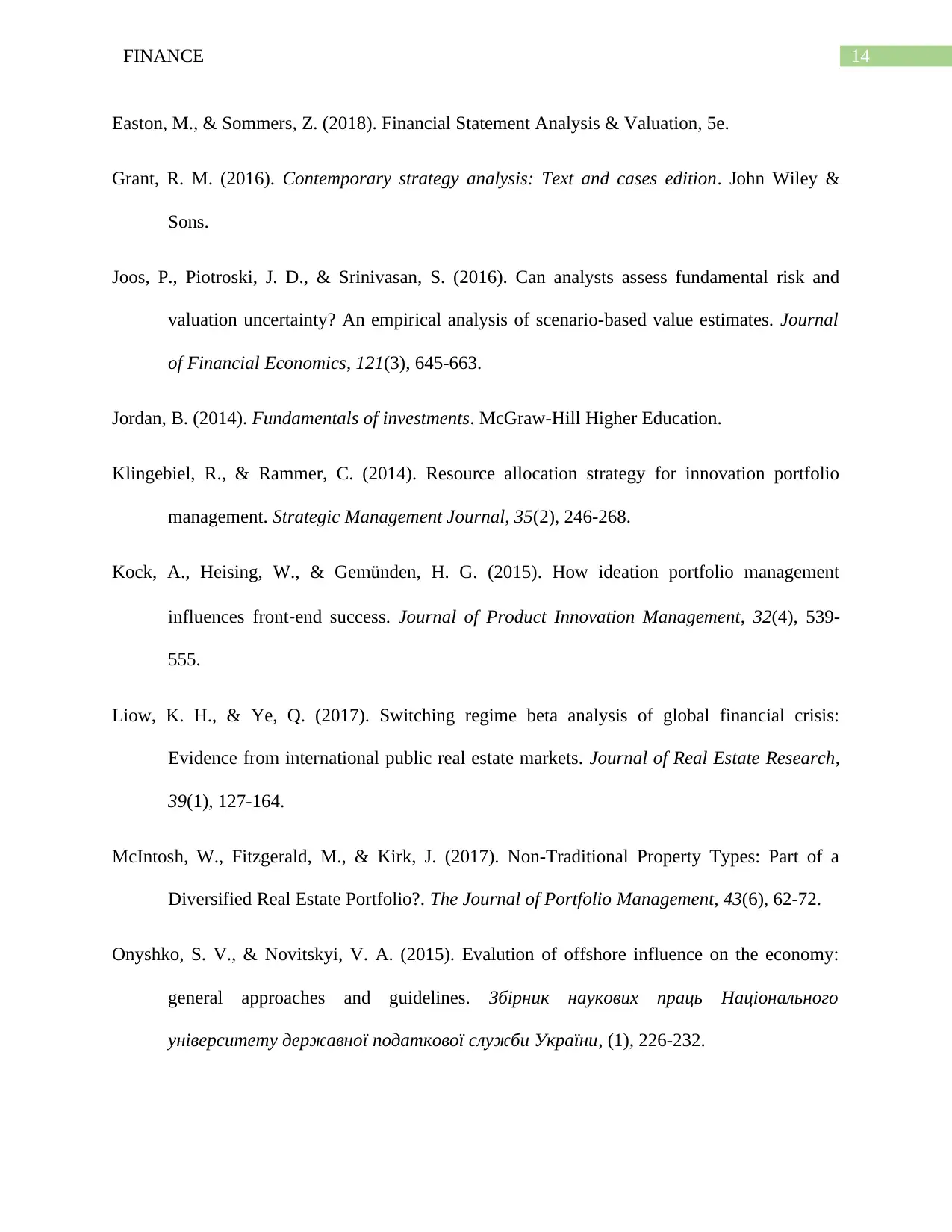
14FINANCE
Easton, M., & Sommers, Z. (2018). Financial Statement Analysis & Valuation, 5e.
Grant, R. M. (2016). Contemporary strategy analysis: Text and cases edition. John Wiley &
Sons.
Joos, P., Piotroski, J. D., & Srinivasan, S. (2016). Can analysts assess fundamental risk and
valuation uncertainty? An empirical analysis of scenario-based value estimates. Journal
of Financial Economics, 121(3), 645-663.
Jordan, B. (2014). Fundamentals of investments. McGraw-Hill Higher Education.
Klingebiel, R., & Rammer, C. (2014). Resource allocation strategy for innovation portfolio
management. Strategic Management Journal, 35(2), 246-268.
Kock, A., Heising, W., & Gemünden, H. G. (2015). How ideation portfolio management
influences front‐end success. Journal of Product Innovation Management, 32(4), 539-
555.
Liow, K. H., & Ye, Q. (2017). Switching regime beta analysis of global financial crisis:
Evidence from international public real estate markets. Journal of Real Estate Research,
39(1), 127-164.
McIntosh, W., Fitzgerald, M., & Kirk, J. (2017). Non-Traditional Property Types: Part of a
Diversified Real Estate Portfolio?. The Journal of Portfolio Management, 43(6), 62-72.
Onyshko, S. V., & Novitskyi, V. A. (2015). Evalution of offshore influence on the economy:
general approaches and guidelines. Збірник наукових праць Національного
університету державної податкової служби України, (1), 226-232.
Easton, M., & Sommers, Z. (2018). Financial Statement Analysis & Valuation, 5e.
Grant, R. M. (2016). Contemporary strategy analysis: Text and cases edition. John Wiley &
Sons.
Joos, P., Piotroski, J. D., & Srinivasan, S. (2016). Can analysts assess fundamental risk and
valuation uncertainty? An empirical analysis of scenario-based value estimates. Journal
of Financial Economics, 121(3), 645-663.
Jordan, B. (2014). Fundamentals of investments. McGraw-Hill Higher Education.
Klingebiel, R., & Rammer, C. (2014). Resource allocation strategy for innovation portfolio
management. Strategic Management Journal, 35(2), 246-268.
Kock, A., Heising, W., & Gemünden, H. G. (2015). How ideation portfolio management
influences front‐end success. Journal of Product Innovation Management, 32(4), 539-
555.
Liow, K. H., & Ye, Q. (2017). Switching regime beta analysis of global financial crisis:
Evidence from international public real estate markets. Journal of Real Estate Research,
39(1), 127-164.
McIntosh, W., Fitzgerald, M., & Kirk, J. (2017). Non-Traditional Property Types: Part of a
Diversified Real Estate Portfolio?. The Journal of Portfolio Management, 43(6), 62-72.
Onyshko, S. V., & Novitskyi, V. A. (2015). Evalution of offshore influence on the economy:
general approaches and guidelines. Збірник наукових праць Національного
університету державної податкової служби України, (1), 226-232.

15FINANCE
Satyanarayana, I., & Naresh, N. S. A. (2015). Evalution of Fixed Assets Management.
International Journal of Scientific Research and Management, 3(3).
Vivanco, J. S., Gonzalez, M., & Martinez, D. C. (2018, May). Social Effects For Using The
Index Beta For Investment Risk Prediction As A Base Of Enterprise Sustainability In
Developing Countries. In ICPESS (International Congress on Politic, Economic and
Social Studies) (No. 4).
Satyanarayana, I., & Naresh, N. S. A. (2015). Evalution of Fixed Assets Management.
International Journal of Scientific Research and Management, 3(3).
Vivanco, J. S., Gonzalez, M., & Martinez, D. C. (2018, May). Social Effects For Using The
Index Beta For Investment Risk Prediction As A Base Of Enterprise Sustainability In
Developing Countries. In ICPESS (International Congress on Politic, Economic and
Social Studies) (No. 4).
Secure Best Marks with AI Grader
Need help grading? Try our AI Grader for instant feedback on your assignments.
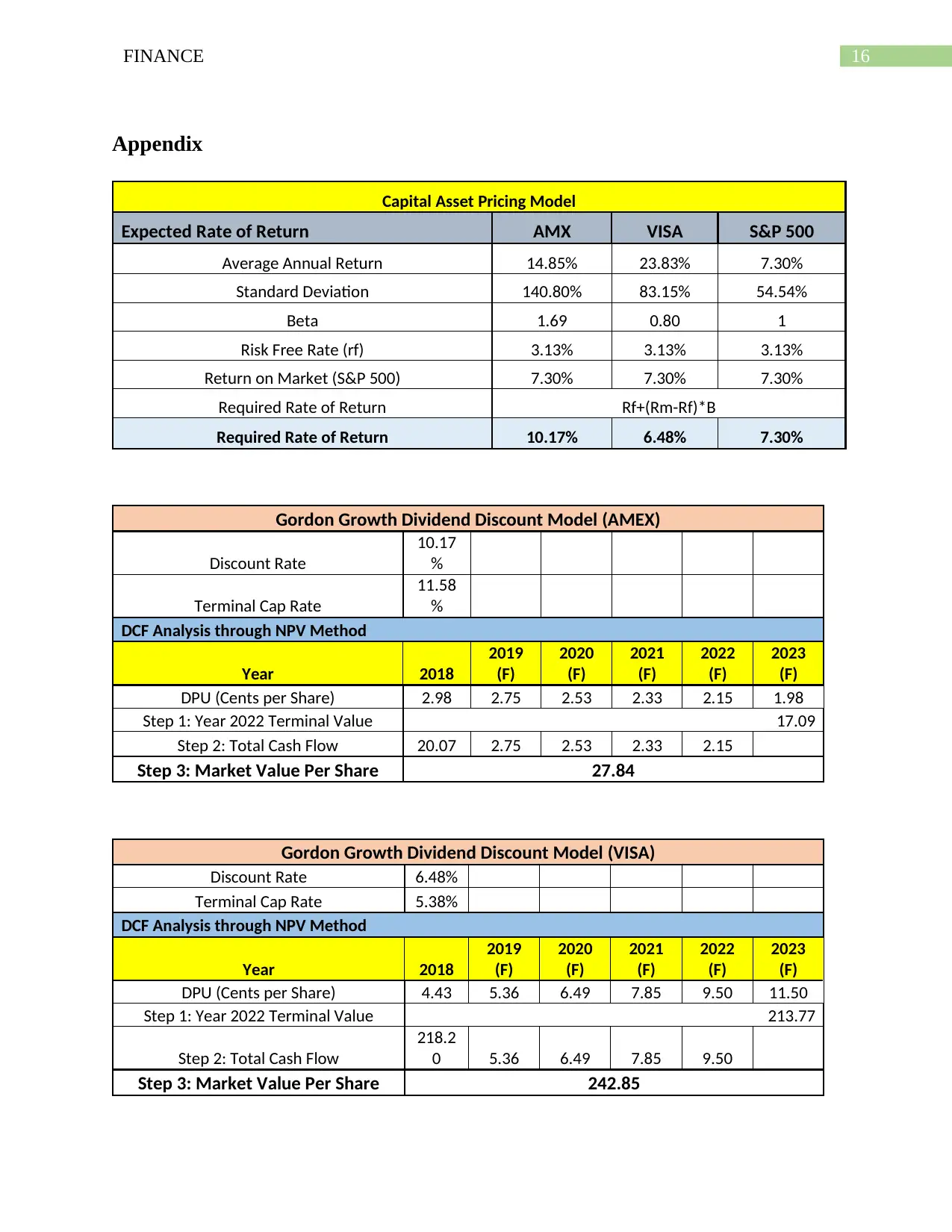
16FINANCE
Appendix
Capital Asset Pricing Model
Expected Rate of Return AMX VISA S&P 500
Average Annual Return 14.85% 23.83% 7.30%
Standard Deviation 140.80% 83.15% 54.54%
Beta 1.69 0.80 1
Risk Free Rate (rf) 3.13% 3.13% 3.13%
Return on Market (S&P 500) 7.30% 7.30% 7.30%
Required Rate of Return Rf+(Rm-Rf)*B
Required Rate of Return 10.17% 6.48% 7.30%
Gordon Growth Dividend Discount Model (AMEX)
Discount Rate
10.17
%
Terminal Cap Rate
11.58
%
DCF Analysis through NPV Method
Year 2018
2019
(F)
2020
(F)
2021
(F)
2022
(F)
2023
(F)
DPU (Cents per Share) 2.98 2.75 2.53 2.33 2.15 1.98
Step 1: Year 2022 Terminal Value 17.09
Step 2: Total Cash Flow 20.07 2.75 2.53 2.33 2.15
Step 3: Market Value Per Share 27.84
Gordon Growth Dividend Discount Model (VISA)
Discount Rate 6.48%
Terminal Cap Rate 5.38%
DCF Analysis through NPV Method
Year 2018
2019
(F)
2020
(F)
2021
(F)
2022
(F)
2023
(F)
DPU (Cents per Share) 4.43 5.36 6.49 7.85 9.50 11.50
Step 1: Year 2022 Terminal Value 213.77
Step 2: Total Cash Flow
218.2
0 5.36 6.49 7.85 9.50
Step 3: Market Value Per Share 242.85
Appendix
Capital Asset Pricing Model
Expected Rate of Return AMX VISA S&P 500
Average Annual Return 14.85% 23.83% 7.30%
Standard Deviation 140.80% 83.15% 54.54%
Beta 1.69 0.80 1
Risk Free Rate (rf) 3.13% 3.13% 3.13%
Return on Market (S&P 500) 7.30% 7.30% 7.30%
Required Rate of Return Rf+(Rm-Rf)*B
Required Rate of Return 10.17% 6.48% 7.30%
Gordon Growth Dividend Discount Model (AMEX)
Discount Rate
10.17
%
Terminal Cap Rate
11.58
%
DCF Analysis through NPV Method
Year 2018
2019
(F)
2020
(F)
2021
(F)
2022
(F)
2023
(F)
DPU (Cents per Share) 2.98 2.75 2.53 2.33 2.15 1.98
Step 1: Year 2022 Terminal Value 17.09
Step 2: Total Cash Flow 20.07 2.75 2.53 2.33 2.15
Step 3: Market Value Per Share 27.84
Gordon Growth Dividend Discount Model (VISA)
Discount Rate 6.48%
Terminal Cap Rate 5.38%
DCF Analysis through NPV Method
Year 2018
2019
(F)
2020
(F)
2021
(F)
2022
(F)
2023
(F)
DPU (Cents per Share) 4.43 5.36 6.49 7.85 9.50 11.50
Step 1: Year 2022 Terminal Value 213.77
Step 2: Total Cash Flow
218.2
0 5.36 6.49 7.85 9.50
Step 3: Market Value Per Share 242.85

17FINANCE
Appendix 2
2) Beta Analysis of VISA Inc.
SUMMARY
OUTPUT
Regression Statistics
Multiple R 0.52765429
R Square 0.27841905
Adjusted R
Square 0.27141341
Standard Error
0.05942672
2
Observations 105
ANOVA
df SS MS F
Significance
F
Regression 1 0.140350724
0.14035072
4
39.7421
3 7.30567E-09
Residual 103 0.363748129
0.00353153
5
Total 104 0.504098852
Coefficients
Standard
Error t Stat P-value Lower 95% Upper 95%
Intercept
0.01496503
3 0.005851109
2.55764036
2
0.01199
5
0.00336073
8
0.02656932
8
X Variable 1
0.80442221
9 0.1276023
6.30413575
3 7.31E-09
0.55135315
4
1.05749128
5
Appendix 2
2) Beta Analysis of VISA Inc.
SUMMARY
OUTPUT
Regression Statistics
Multiple R 0.52765429
R Square 0.27841905
Adjusted R
Square 0.27141341
Standard Error
0.05942672
2
Observations 105
ANOVA
df SS MS F
Significance
F
Regression 1 0.140350724
0.14035072
4
39.7421
3 7.30567E-09
Residual 103 0.363748129
0.00353153
5
Total 104 0.504098852
Coefficients
Standard
Error t Stat P-value Lower 95% Upper 95%
Intercept
0.01496503
3 0.005851109
2.55764036
2
0.01199
5
0.00336073
8
0.02656932
8
X Variable 1
0.80442221
9 0.1276023
6.30413575
3 7.31E-09
0.55135315
4
1.05749128
5
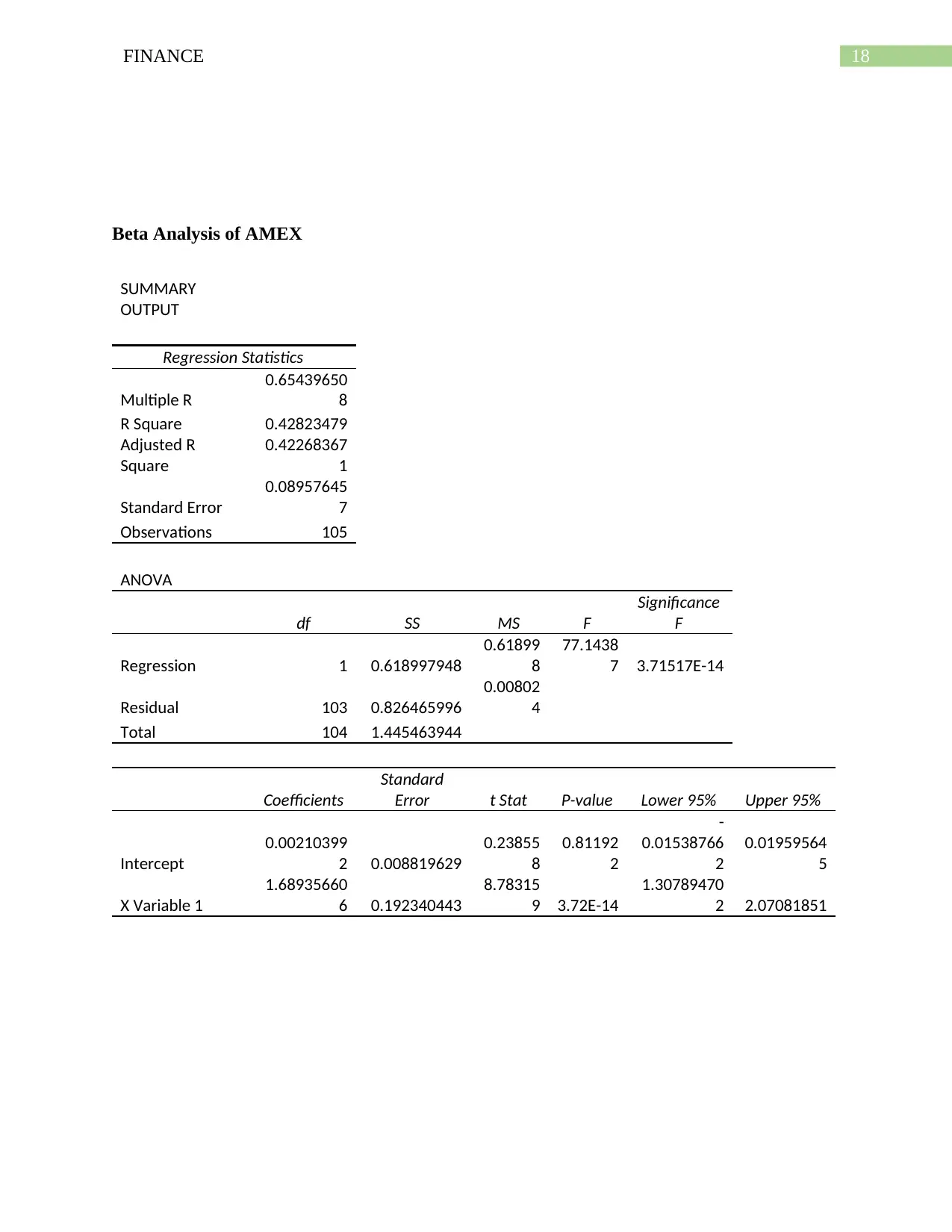
18FINANCE
Beta Analysis of AMEX
SUMMARY
OUTPUT
Regression Statistics
Multiple R
0.65439650
8
R Square 0.42823479
Adjusted R
Square
0.42268367
1
Standard Error
0.08957645
7
Observations 105
ANOVA
df SS MS F
Significance
F
Regression 1 0.618997948
0.61899
8
77.1438
7 3.71517E-14
Residual 103 0.826465996
0.00802
4
Total 104 1.445463944
Coefficients
Standard
Error t Stat P-value Lower 95% Upper 95%
Intercept
0.00210399
2 0.008819629
0.23855
8
0.81192
2
-
0.01538766
2
0.01959564
5
X Variable 1
1.68935660
6 0.192340443
8.78315
9 3.72E-14
1.30789470
2 2.07081851
Beta Analysis of AMEX
SUMMARY
OUTPUT
Regression Statistics
Multiple R
0.65439650
8
R Square 0.42823479
Adjusted R
Square
0.42268367
1
Standard Error
0.08957645
7
Observations 105
ANOVA
df SS MS F
Significance
F
Regression 1 0.618997948
0.61899
8
77.1438
7 3.71517E-14
Residual 103 0.826465996
0.00802
4
Total 104 1.445463944
Coefficients
Standard
Error t Stat P-value Lower 95% Upper 95%
Intercept
0.00210399
2 0.008819629
0.23855
8
0.81192
2
-
0.01538766
2
0.01959564
5
X Variable 1
1.68935660
6 0.192340443
8.78315
9 3.72E-14
1.30789470
2 2.07081851
1 out of 19
Related Documents
Your All-in-One AI-Powered Toolkit for Academic Success.
+13062052269
info@desklib.com
Available 24*7 on WhatsApp / Email
![[object Object]](/_next/static/media/star-bottom.7253800d.svg)
Unlock your academic potential
© 2024 | Zucol Services PVT LTD | All rights reserved.





